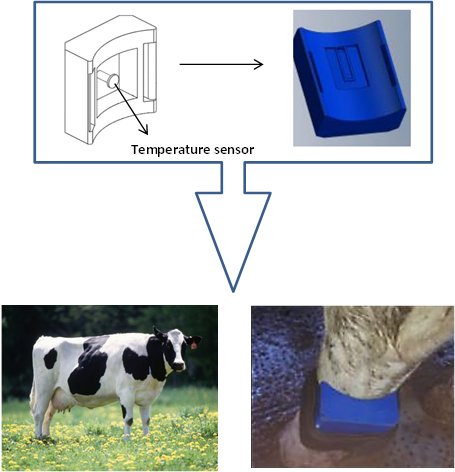Increased body temperature in cattle is associated with several diseases, such as foot-and-mouth disease, leptospirosis, tick-borne diseases, bovine viral diarrhoea, and others, which affect performance and productivity, as well as animal welfare. In addition, the body temperature of cattle varies regularly with the reproductive cycle and has been used to evaluate the regularity of oestrus and ovulation, pregnancy, and calving. Measuring rectal temperatures using a thermometer is the most common way of measuring the temperature of animals. However, this is not always an easy task, because it involves handling animals very closely, with the risk of injuring the operator and increasing animal stress.
Therefore, with the main objective of preventing disease and assisting in reproductive management, Kou et al. (2017) developed an automated system based on a thermistor sensor, namely the Automatic Measurement System for Cattle’s Surface Temperature (AMSCST). The apparatus was developed to adjust to the anatomy of dairy cows’ hind legs and to measure the body temperature at the skin – more precisely, at the metatarsal region, as shown in the figure below.

Figure: Shell-shaped appliance designed for the anatomy of cattle (modified from Kou et al., 2017).
The researchers successfully developed an automated technological solution to accurately measure the body temperature of cattle, through the invention of a device and the establishment of the AMSCST system. To assess the accuracy of the equipment, a test was performed which compared the automated system with the conventional technique, i.e. using a commercially available veterinary mercury thermometer to measure the animals’ rectal temperature. The experiment was carried out in China on seven multiparous (60–90 days postpartum) Simmental cows kept in a free-stall barn. The temperature was measured with both an AMSCST and a thermometer in the winter, summer, and autumn.
The data detection devices were attached to the metatarsus of the hind legs to measure the superficial temperature. The superficial temperature was measured every hour by the data detection devices (the data were collected every four hours and was continuously measured for three days using the AMSCST. The rectal temperature was measured every two hours by a veterinary mercury thermometer inserting into the rectum for five minutes to record the temperature, which was continuously measured for three days.
The results indicated that the temperatures measured by the AMSCST were closely related to those measured by the mercury thermometer (R2 = 0.998), suggesting that the automated system is an accurate and reliable method for detecting the body temperature of cattle. If implemented on farms, this automated system could assist farmers in the monitoring of animals’ health and could allow illnesses to be detected earlier. This initial procedure can avoid the reduction of productive performance (weight gain), not to mention the loss of animals.
Additional information about the device:
specifications of the AMSCST animal physiological state detector in vitro – length: 80 mm, height: 74 mm, thickness: 24 mm; patent number: CN201520869032.5 (as shown in the figure above and as described in the article)
Impact on:
 | |
 | The sensor can aid in early disease diagnosis. |
 | The early diagnosis of the disease can prevent a reduction in animal performance. |
 | Early detection may help reduce the use of veterinary medication. |
Authors: Virginia C. Resconi, Jakeline Vieira Romero.
Literature Source:
- Kou et al. 2017. Plos One. Automated measurement of cattle surface temperature and its correlation with rectal temperature. V.4:1-10. https://doi.org/10.1371/journal.pone.0175377